Anime is something that is very much a part of my life, from 5th grade where I spent every morning sitting in my living with a bowl of cereal and watching Sailor Moon to hanging out with my friends last night watching Hayate no Gotoku!. It is something that I'm passionate about.
Why? Well, having grown up in America, I was very limited in what I was exposed to, simply because America is a country obsessed with political correctness. Japan however is so different creatively that, to me, anime is refreshing and awe-inspiring. It's a beautiful medium, but unfortunately the bulk of America does not agree with me, either because they tried it and liked it, or simply do not want to give it a try at all.
So, I decided to write an in-depth piece to answer some questions. Why is anime viewed in such a negative manner without many even being exposed to it at all? Why is the industry suffering in America? As anime fans, can we do anything to help the genre we love so much? Would we even want to deal with the ramifications of having something so precious to us be considered 'popular' by American standards? Whether you're an anime fan or not, you might want to stay tuned, there is plenty to learn.
The truth of the matter is that we humans in general are wary of what we do not understand. Humans are creatures of habit; we form routines and stick to them, comforted in the knowledge that we know every part and step of it through and through. Americans are firm in their beliefs and how they were raised, and that, in my opinion, contributes largely to the anime industry's unfavorable reputation, even when most of the country has never even viewed anime, or, in many cases, never even heard of it. I have broken it down into two topics which I think cover a good bulk of the issue.
Cultural Differences
Any anime fan will tell you that anime is chock-full of references to Japanese history and culture. American programs are the same way, but because America is such a large and influential nation, a lot of shows, music, and books that we take cultural pieces from are available all over the world. This is not the case with Japanese shows, music, and books in America, and so a lot of the things you see in anime can seem very confusing at first, especially if you are not familiar with anime or are new to it. Here are some examples:
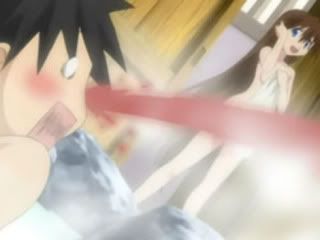
In anime, you may see a man's nose start suddenly spewing copious amounts of blood. It is rumored that the Japanese believe that when a man sees a woman he finds attractive, his heart begins to race faster and starts pumping more blood, resulting in a possible nosebleed. Whether this is true or not, when you see it in an anime, it means the man in question is seriously aroused. Seriously.
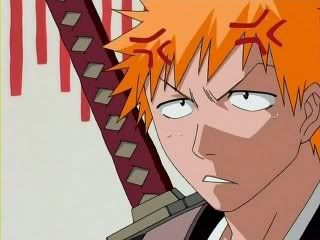
The red marks you see above adorning Ichigo's head have perplexed many a beginner anime fan. These marking are actually used to represent blood veins, and their presence on his head is meant to represent a vein about to pop in his head. In other words, he's angry and frustrated. You'll see this a lot in other anime as well.
Here's a few more:
- A sweat drop hanging off of a character's head is an indication that they feel embarrassed, either for themselves or for someone in the area who's being an idiot.
- Holding up your pinky while talking to someone in an anime means that you are referring to that person's significant other.
- Those triangular white thingies with the green square on them are in fact food. It's called an onigiri, or rice ball. The green square on them is actually seaweed, and having one or two of them is considered a traditional on-the-go breakfast in Japan.
Like I said, there are many, many others, but these are just a few of the more common ones. Because these things are not commonplace to Americans, they can be seen as confusing, and too much confusion will inspire anyone to turn off the television and grab a bottle of aspirin. I know I have had several people refer to seeing these things and say that it turned them off to anime, and I'm sure they're not the only ones.
The American Cartoon Stigma
Americans tend to view animation as a purely children's medium. I find this very ironic, since shows like The Simpsons, King of the Hill, and Family Guy have been around for years and are very popular. Don't think that America is the first country to create an animated series driven towards adults; in fact, anime has always mostly been for adults and teenagers. Any genre of television program or movie you can think of in America, you can find in anime form in Japan. Here are some great examples of genres and an anime series that fits the criteria.

Itazura na Kiss (The Mischievous Kiss) is about a girl, Kotoko, who is rejected by the man she loves, Naoki. Through certain events, she winds up living with him in his house, and being forced to live side-by-side begins to change the both of them as they prepare to graduate High School and start on their own paths.
This is the perfect example of a sitcom (which, lets remember, stands for situational comedy!). Many shows like Friends are based around the drama of friends and enemies living together, and that dynamic has always bred both serious, tender moments and outright hilarious ones. Itazura na Kiss encompasses all of this. The only difference is it's animated.

Welcome to the NHK (which, by the way, stands for Nippon Hōsō Kyōkai, a major television broadcasting company in Japan) is a show about a man named Sato, who is a hikikomori (basically, a slightly agoraphobic recluse) who comes upon the kindness of a girl who is intent on helping him break out of his ways and gain control of his life back. This anime is a rather deep drama, exploring the dark sides of every character in the show and exposing how everyone, in some capacity, has a struggle of their own, and that nobody can truly make it through anything by themselves.
While I don't think there's anything quite like Welcome to the NHK out in America right now, many dramatic shows and movies explore the same set of themes, breaking down the human condition for all to see.
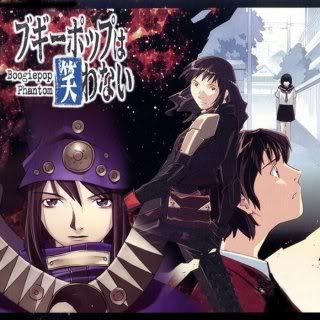
Boogiepop Phantom is the story of an event that happened 5 years ago. A huge beam of light crashed down, and several murders occurred. This 12 episode series goes through the perspectives of several people involved in these murders who somehow gained mysterious powers from the beam of light, supposedly given to them by the Death God only known as the Boogiepop.
This story sort of mashes together many of today's popular supernatural television shows along with the overly-populated horror movie genre of America. Again, there's nothing exactly like this show in America, but its a combination of several popular genres.
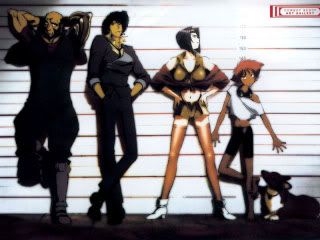
Cowboy Bebop is an action story set in space. Spike and his friends roam around space catching bounties for money, just trying to fill their stomachs. However, as their pasts catch up to them, we get to see them change and grow, swirling into a shocking and emotional climax that shook the anime world.
This one of the most classic anime series' of all time, and a must-watch for any anime fan new or old. The high-paced action coupled with futuristic technology is reminiscent of some of the most classic American action films of all time.
These are just some examples of shows that are very much like some of America's most popular films and programs, they're just animated. Animation is great for these types of things because you can draw things that no amount of special effects could really muster, opening up a ton of creative opportunities. The fact that such an opportunity is lost on America is one of the saddest things about the bad rap anime has in America.
This is a topic that is probably the most vital to the anime industry. Like every other business in America nowadays, the anime industry is suffering from lack of money and support. However, I would like to explore some of the reasons why I think this is, starting with the most important and controversial topic of all.
Downloading and Streaming
What a great idea, right? Anime fans can download and stream videos of anime online to check out what's new and to test out new anime before they buy it, and its a cheap way to get new people into anime. So, what could go wrong?
Simple. Nobody goes out and buys the damn stuff.
The possibilities listed above are great, but people are either too lazy or greedy to spend their money on the official products, or they simply cannot afford them. This greatly brings down the money going into the industry, and therefore causes anime companies to let people go or skimp on certain things. A great example of this is Media Blasters, who has lately been dropping the process of getting American voice actors to dub their work and instead simply putting English subtitles on their work and releasing it that way to cut costs.
The cycle goes like this: People download and stream, but don't buy. Because of that, companies lose money and they have to jack up the costs of anime DVDs to stay profitable. The prices get so high, nobody wants to buy them, and so they resort to downloading and streaming, and it goes on and on like that. Truly it is a destructive cycle.
Let's talk about fansubbers briefly. For those of you who don't know, a fansub group is a group of people who take it upon themselves to translate and subtitle an anime, then post it online for people to download and enjoy. So what are some of the things that go in to fansubbing? Well, I happen to be good friends with a fansub group, and these are just some of the things they have to go through to bring the anime to you:
- Finding a good quality rip of an episode that will be pleasing to the eye, but not so large in file size that it will be inconvenient to the person downloading it.
- Translate everything that is spoken, which involves finding someone fluent enough in both English and Japanese to be able to make sense of what is being said. They also have to reword it so that it makes sense to an American viewer, as the Japanese, like us, have terms and phrases they use that we would not understand.
- Time the subtitles to fit with the spoken words and program them into the video file.
Obviously, this is a huge labor of love. Most fansub groups do this out of pure love and passion for the series in question, but some do try to put them onto DVD and sell them, which is (obviously) highly illegal. Adding that to the pot of everything else above makes the positives of anime downloading and streaming harder and harder to grasp at. Lack of funding will make any business collapse, and so this issue is very much the cornerstone of the troubles the American anime industry is having.
Censorship
Like I stated in the beginning, the creative minds of the Americans and the Japanese are very different. While we are obsessed with not offending anyone, Japan is much more lax in this regard, specifically in violent and sexual content and how it is portrayed. While any American parent would be horrified to have their child exposed to such a thing, the Japanese find it to be a comical device, and it is often found, in small doses of course, in many children's programs.
However, here, it is censored. Because much of an anime series' magic can come from some of its more violent or sexually humerous scenes, a lot of the poignancy of a story can be lost due to censorship. Or, it can just be plain hilarious, confusing, and infuriating. Here are some great examples of censorship of anime in America.

Everything from blood to guns is often cut out of anime. Here are some shows that have been a victim of this.
- Yu-Gi-Oh!, believe it or not, is normally chock-full of guns, but they were all edited out in America. Instead, the bad guys do a lot of...pointing. Yeah.
- Sailor Moon was also cut due to this. There was a scene where Rini, a.k.a. Sailor Chibi Moon, pulls a toy gun on Sailor Moon herself, but that was considered too naughty for the kids, even when a flag popped out of it after Rini pulled the trigger!
- Saint Seiya is normally full of blood, but when it came to America, the blood was changed to a blue-green color, and was referred to as 'Mystical Energy'. Yeah, I'm totally buying that one.
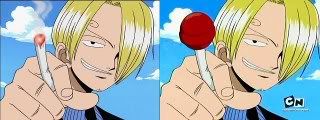
Replacing things like cigarettes with random items is a very common type of censorship in America when it comes to anime. Here are some other examples:
- Dragonball Z is the victim of this in many ways. Many DBZ characters are actually smokers, but you'd never know because they all got erased. There's also lots of nudity and peeing on people's heads in this show, but that's a whole different issue.
- Sailor Moon herself had an episode in America where she got 'silly' after drinking too much 'punch'. Suuuure.
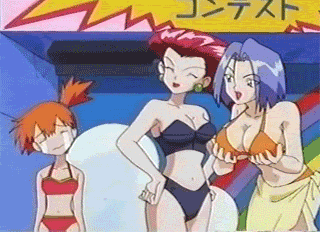
Nudity, cross dressing, and homosexuality are big a big no-no when it comes to cartoons in America, and so the above episode of Pokémon was actually never aired. The other big instance of this is Sailor Moon. Here's what was censored:
- Just about all of the Sailor Scouts' transformation sequences were censored in America, as they had nipples showing! The only Scout to actually have a chunk of their sequence cut out completely, though, was Sailor Jupiter; at one point, her skirt flies up, and so they cut that out completely.
- Zoicite, one of Queen Beryl's henchwoman, was actually a henchmen in Japan. His relationship with Malachite was still in-tact in Japan, meaning, GASP, they were gay together!
- Sailor Neptune and Sailor Uranus were portrayed as cousins in America, but in reality, they're lovers.
- The Sailor Starlights were three women who were looking for their Princess. To do this, they masqueraded as a boy band singing group, and then transformed into their true Sailor Scout selves when in battle. Because of all the gender-bending, they actually cut the series off in America right before they were introduced.
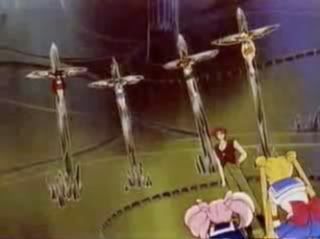
Religion is a very sensitive issue in America, and so scenes like the one above were cut out completely. The last episode of the first season of Sailor Moon was in fact a two-parter, but they edited it so severely that it got truncated into one single episode, mostly because the dead bodies of the Scouts were hanging in a cross-like position for most of the time. Nice.
As you can see, a lot of censoring goes on in anime in America, and while it may be good for the kids, it pisses of the hardcore anime fans, and that turns them off to the point where they don't want to support the official releases. The past couple of years, however, have seen a rash of uncut anime DVDs being released, and many FUNimation shows are released in both TV edited and unedited versions.
Alterations of an Original Series
This not only angers anime fans, but its not even useful like the censorship sometimes is. A lot of names and storyline are simplified so that it can be easier for American audiences to understand, but it can also ruin the integrity of a series.
Here are some examples of some theme song changes.
- Saint Seiya, aside from the censoring of blood mentioned above, got its ass handed to it in other ways. It was renamed 'Knights of the Zodiac' when it came to America, and its original opening theme, Pegasus Fantasy, got replaced with a sub-par cover of the Flock of Seagulls' hit I Ran. Makes me cringe just watching it.
- Sailor Moon keeps getting mentioned, but it got screwed over that badly. It's original opening, Moonlight Densetsu, had its lyrics translated into English. However, the words in English have nothing to do with the original lyrics of the song.
- Ronin Warriors, known in Japan as Yoroiden Samurai Troopers, not only got a whole new opening that was not really a song so much as it was a speech about how great they were, but they mixed up the armors and voices!
Here's some examples of some name change issues:
- Sailor Moon, for the last time I swear! The five main characters in Japan were named Usagi, Ami (Ah-mee), Rei, Makoto, and Minako. In America, they were Serena, Amy, Raye, Lita, and Mina. Some of these names do sound sort of alike. Interestingly enough though, in the Sailor Moon comics, Usagi was not known as Serena, but as Bunny, which is the literal translation of the word 'Usagi' (This all stemming from the fact that she's Sailor Moon and there's a custom in Japan involving a rabbit in the moon). Like I said, these changes make sense to a small degree, but changing the name Naru to Molly, or Mamoru to Darien? Come on now!
- Names can also be horrible mispronounced. Ryu Hoshi of Street Fighter fame is known in America as 'Rhai-you', when it is meant to be pronounced 'Ree-yo'.
The way all of the above affects an anime as a whole is largely the reason, in my opinion, why the American anime industry is having so much trouble, which brings me to the last two parts of this whole beautiful thing.
Well, here are some ways I can think of for anime fans to help change what we've seen here.
- Supporting the industry financially is probably the biggest. Buy the official releases! Feel free to show streams and downloads to your friends, but urge them to buy the official releases themselves, and don't make copies of your DVDs for them; you're only making it worse! Also, use your voice to spread the word about how downloading and streaming affects the industry!
- Getting involved with the industry itself is another great idea. Attending anime conventions is a great way to not only keep up on the latest news, but to also purchase official merchandise you'd never find anywhere else. Also, if you want to see an anime you know of brought over to America, e-mail some anime companies such as ADV, Bandai, and FUNimation and tell them what you want! If they see the fanbase, they'll put forth the effort (we hope)!
- Share the anime love with everyone! Invite friends over for a night of watching anime, and invite anyone who may be curious about anime. A nice big group of people is perfect for answering questions and giving opinions on the best way to start watching anime. If you see an anime that you think a friend may like, suggest it to them!
While these may not do much, they are some things we can do to improve the situation. However, that raises one final question.
On my Facebook, I started adding a bunch of my favorite j-pop and j-rock to my iLike application, then posted some of my favorite songs and videos with messages urging my non-anime loving friends to give the music a try. My friend Spyke then yelled at me, telling me to stop urging others to listen to it, because if it became popular in America, it would somehow be ruined. How can you blame him for being afraid of that, given what you've read above?
Because of the way anime is treated in America, many anime fans are reluctant to see new anime come over. However, by keeping active in the industry and supporting what you love, you can show these companies that we prefer the good ol' unedited, original stuff. Also, we should all keep in mind that the Japanese anime companies do make money off of the American releases, and so I believe that fact should also be taken into account in these matters. It's not as if anime will just disappear from America if we keep this up; it will also affect Japan's anime industry.
So, in the end, the decision is really yours. If you're not an anime fan, you can either try to get into it or just not bother. If you already are one, you can try to learn more about it and get involved in the industry, or you can just keep on being a casual watcher. Nobody can force anyone to do anything in this situation.
However, my choice is clear: I choose to be active and support the anime industry by informing others, buying my favorite titles whenever I have the financial ability to, and to just keep on enjoying it and sharing it with my friends.
Because in the end, anime is meant to be enjoyed. This is all just about preserving that enjoyment.
